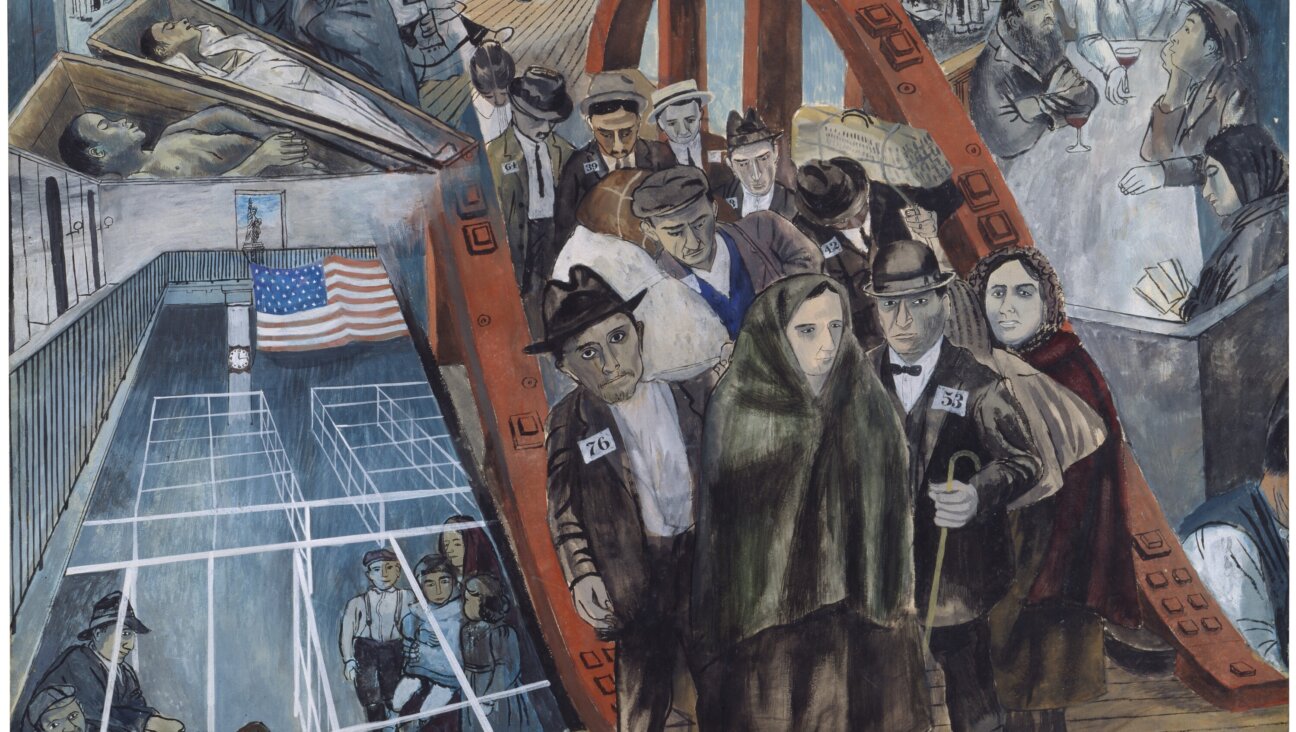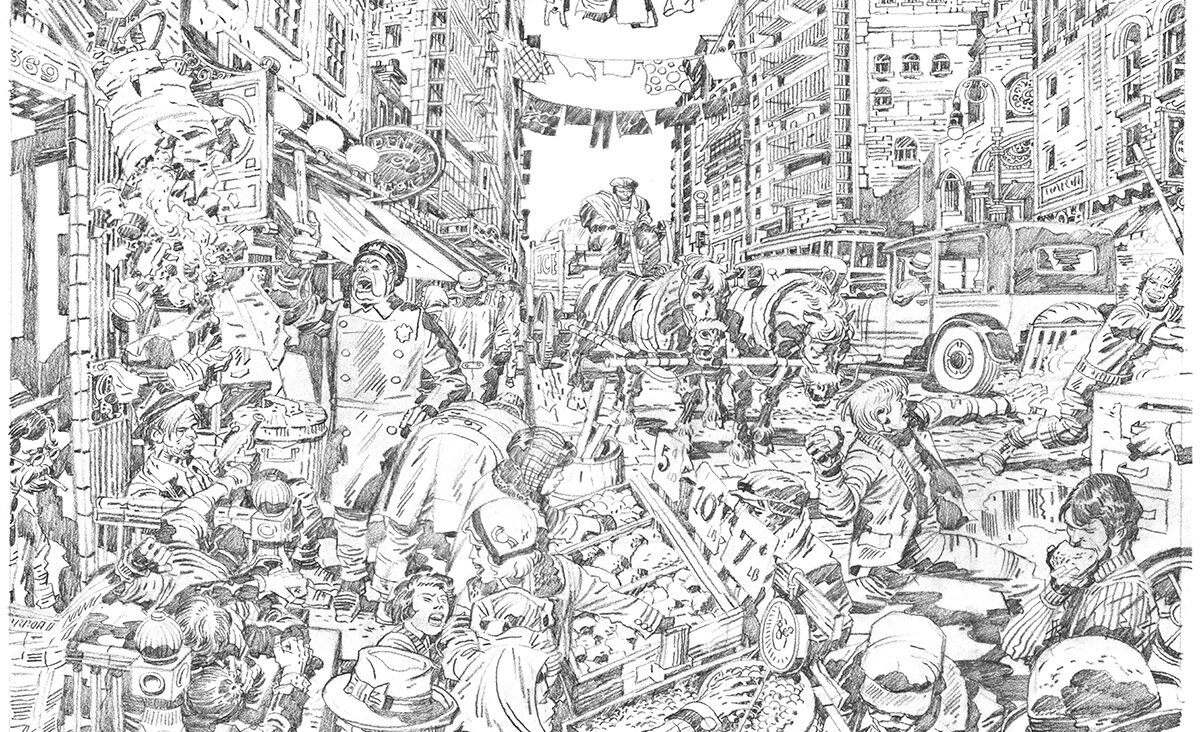How Sex And Power Collude — The Uncompromising Art Of Nancy Spero

A detail from “Maypole: Take No Prisoners,” by Nancy Spero. Image by Anya Ulinich
In a civilization neurotic with branding, some artists are identified as simply “artists,” while others get qualified. Nancy Spero, whose wonderful work is now a subject of a major show at MOMA PS1, is often called a “political artist,” or “artist and activist.” Even as they attempt to be merely descriptive, or even honorific, such qualifiers act as subtle disses. This is because when we consider them in their original sense, they are redundant — every person with a struggle is an activist; every artist in society is political, and ones claiming not to be political are making the loudest political statement of all — namely, “let’s quit the game while we’re ahead.” In their conventional sense, “activist” or “political artist” are terms that imply mission-driven detachment, an impersonal dedication to a noble cause. What makes Spero’s work so affecting is that her life-long art practice, from her most introspective pieces to her activism, amounts to a deeply personal, uncompromising expression of her experience.
Born in Cleveland in 1926, Spero attended the Art Institute of Chicago, graduating in 1949. At this time, Abstract Expressionism was becoming the dominant idiom in the New York art world, with figurative art being de-facto delegitimized and labeled retrograde. Work by Jackson Pollock, Barnett Newman, and Mark Rothko were seen as the ultimate culmination of art’s journey away from making “pictures” toward the pure act of mark making. According to the critic Harold Rosenberg, “The big moment came when it was decided to paint ‘just to paint.’ The gesture on the canvas was a gesture of liberation from value — political, aesthetic, moral.” Like a gang of Buddhas, Abstract Expressionists claimed to have attained the ultimate freedom in their work: the kind of freedom that is possible in the darkest of jail cells, the freedom of being merely a process in the universe. Ironically, this radical form of painting, by definition scrubbed clean of social awareness and psychological content, also made no demands and asked no questions, and so was happily acceptable to the Cold War American establishment. America wanted to be seen as the Land of the Free, and Abstract Expressionism, manly and heroic yet void of any reference to life’s pesky un-freedoms, became mainstream in the McCarthy era.

A detail from “Notes In Time,” by Nancy Spero Image by Anya Ulinich
The art world of 1950s Chicago may as well have been another planet. Highly individualized, emotional, existentialist figurative art thrived there. Chicago artists drew their influences from history and ethnography, self-taught art and surrealism, philosophy and psychoanalysis, and the human figure was central to their work. Nancy Spero and her husband, the painter Leon Golub, were part of this scene, which included an unusually high number of female artists.
Like most married women of her generation, Nancy Spero didn’t exactly plan how she was going to combine having children with an art career. By the time she was 28, she was an exhausted mother of two infant boys. She painted by night, beginning a striking body of work that she called Black Paintings, continuing to work on them after she and Golub moved Paris in 1959. Several of these are on display at PS1. Their labored backgrounds convey a sense of claustrophobia and intense deliberation. They are dark and luminous at the same time: traces of marks, overridden and obliterated, scraped and reapplied, appear in layers that at times become transparent, letting the bare canvas show through. The figures emerge from these tormented fields, monumental but also baffled — as if they don’t know how to handle their own power, or quite how they are related to one another. A painting called “Lovers,” apparently a portrait of the artist and her husband, shows a couple about to have sex. The man moves into the woman’s space, crowding both figures into the left half of the canvas. The woman looks frozen, eager and recoiling at the same time, limbless. There is a lot of movement in this painting, yet both characters wear exaggerated, static smiles like characters in a Greek play. The whole thing has the quality of a nightmare. Another painting, “Mother and Children,” with its elongated, totemic figures, resembles the work of Louise Bourgeois. The huge mother towers over the children, who barely come up to her thigh. But these tiny, bald-headed beings have the proportions of adult figures. They march in lockstep, wearing devious grins, while the mother looks resigned, detached, and ambivalent.
In 1964, Spero and her family moved to New York, where Spero continued to make her Black Paintings until the Vietnam War jolted her. She decided to stop working on canvas and switched to paper as a more democratic medium. Her Vietnam War paintings express three emotions: anger, anguish and horror. Those are fast kinds of feelings, apt to get stalled by gooey oil paint and all the implied responsibility to a stretched canvas, a heavy and fairly expensive object. It seems to me that Spero had always been more of a graphic artist than a painter: line is her natural language, and switching to paper and water-based paint liberated her to create works of maximum emotional urgency: screaming, sexualized humanoid bombs spurting blood from their orifices; aircraft as giant insects or frightening birds, her slashing strokes evoking the violence of helicopter blades; rivers of blood. In one of the paintings, Spero depicts a broken body of a war victim, and then physically obliterates it, rubbing it out of the paper. These works are made to shock, and the parental advisory posted at the entrance to the exhibit likely refers to them. By the time the war had started, Nancy Spero had three boys, and I suspect she had no trouble mentally inserting their draftable bodies into death-filled images of war, causing all the internalized, ruminative intensity that had produced the Black Painting to explode rage.
Nancy Spero has to be among the least withholding artists of the twentieth century. While some of her contemporaries, for example, Gerhard Richter, guard the mystery of their figurative content like a precious asset, Spero was only happy to talk about hers. The show includes Irene Sosa’s wonderful feature-length documentary about Spero, “Woman as Protagonist,” in which Spero gives multiple interviews. The film is hard to hear in the gallery, but it’s available on Vimeo and I recommend that you watch it before seeing the show. “I was trying to show the collusion of sex and power,” Spero says of her War series, “in a way, little boys’ war games to become reality.” When asked why the bombs in her War paintings are sometimes female, she explains: “Women nurtured these monsters. Women, through the ages, have sent their sons and husbands and lovers off to war.”
Spero was sure that her Vietnam paintings would “surely catch the eye.” Except, “there was no eye to catch at that time.“ In the late 1960s the ever-inoffensive New York art world was dominated by Minimalism and Pop, and political artists were entirely shut out of it. Spero’s work appeared in a few anti-war shows, but otherwise remained unseen. In “Woman as Protagonist,” Leon Golub tells of studio visitors who came to look at his work but pointedly ignored Spero’s, sometimes being “quite brutal.” When he notes that she took this with “much grace,” she interrupts, adding “and much bitterness.”
Apart from her relationship with Golub, Spero felt extremely isolated and frustrated in New York. Out of this isolation, and the feeling of being silenced, came “Codex Artaud” — a series of works that engages with the French writer Antonin Artaud, who was confined to mental institutions for much of his life and who also spoke of being silenced, of his tongue being cut off in an act of metaphorical castration. “This is a woman’s complaint,” she says. She felt that Artaud’s voice spoke for her. The bloody projectiles from Vietnam works morphed into protruding, searching tongues in the Artaud series. Spero began to experiment with the format of her drawings, producing long scrolls incorporating collages of Artaud’s texts and fragmented figures. The one-sided conversation between a living artist and a dead one, a bond born of ostracism, had to exhaust itself. But in the course of it, Nancy Spero worked out the formal language that would become her trademark: the combination of repeated, isolated figures from found sources, collage, printmaking, and text.
By the early 1970s, Nancy Spero broke up with Artaud and found her people, as well the venue for her work, becoming a founding member of A.I.R. Gallery — the first cooperative gallery in the U.S. dedicated to the work of women artists. There is a fascinating scene in Sosa’s documentary, where Spero argues against including men in the co-op. “For a while, we need to separate ourselves from the ruling class,” she says, referring to the male-dominated New York art scene. Spero extended the sentiment to her art, deciding that women would become the subject of all her future works. She immersed herself in the study of women in history and mythology, appropriating historical images, from Sheela-na-gigs to Artemis to contemporary images of pin-up models, athletes, survivors of war, and grieving mothers. Interspersed with texts by and about women, from academic articles to poetry, these figures recur and combine in “Notes in Time,” a striking, 200-foot-long sequence of scrolls that gets its own room at PS1. Spero’s technique is collage and hand-printing. The impressions are imperfect, and despite its scale, the richly textured work reads as a personal message. But since so much of Spero’s mature aesthetic has been appropriated by the design vernacular of the 21st century, it’s almost impossible to appreciate the impact it must have had when it was first made.
In the 1980s and 1990s, Spero abandoned text and returned to working with figures alone. Works from this period take up the largest room in the show, and the way they are installed — some all the way up, under the ceiling, mimics the way Spero’s figures appeared in her many site-specific installations. Whether grieving or dancing, either in groups or solitary, Spero’s female figures project irrepressible energy. She uses brighter colors, and many of these later works seem playful and assertive, rather than troubled.
The celebration didn’t last. The heads of victims from Spero’s Vietnam paintings, disembodied, magnified to roughly life-size, and printed on aluminum, return in “Maypole: Take No Prisoners,” a 2007 installation created in response to the war in Iraq. Screaming or merely tormented, some with their tongues protruding, these aluminum heads hang on chains and festive ribbons suspended from a metal pole. Spero’s use of the maypole metaphor, a reference to the annual celebration of the arrival of spring, is striking and macabre, pointing to a recurrent nature of war, the cycle of violence. Spero was eighty one when she made Maypole, and it expresses grief, but also heavy weariness. “It’s the same, it’s no different,” Spero observed. “I did the War Series about Vietnam, and here we are again in the Iraq debacle, watching the same damn thing …” She died two years later, in 2009.
Spero’s entire art practice seems to have been an alternative to the “same damn thing.” What struck me as I watched videos of Spero was the relaxed and non-hierarchical way she interacted with her assistants and collaborators. “Yes, that looks good,” she says to the women who help transfer her images to the walls for site-specific installations. She never raises her voice, as if taking for granted that cooperation and generosity superseded exactitude, that acting in collaboration is as important the final product, offering a non-ego-centric interpretation to the principle that animated Abstract Expressionism. In 1990, at a time when it was becoming common practice for artists to have their work fabricated, Irene Sosa filmed Spero working in Derry, Northern Ireland. The artist and a group of helpers are making prints on a building wall using rubber rollers and wooden spoons. They are watched by children and soldiers, and they’re ignoring the rain.
The show continues through June 23 at PS1
Anya Ulinich is the Forward’s contributing art critic.






















